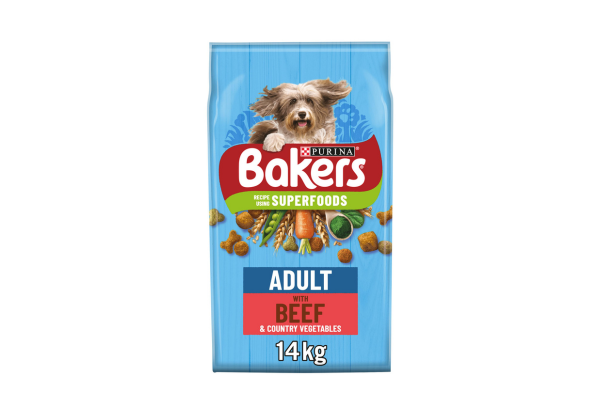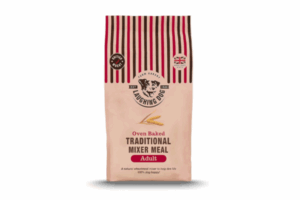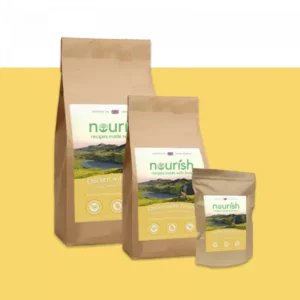When you’re strolling through the pet food aisle at your local supermarket, you’ll likely spot those familiar colorful bags of Bakers dog food. This British brand has been feeding dogs for over 85 years, making it one of the UK’s most recognizable pet food names. But longevity doesn’t automatically equal quality, and as a dog food specialist, I’ve spent considerable time examining what Bakers actually offers our four-legged friends.
Bakers positions itself as a complete and balanced dog food that prioritizes taste alongside nutrition. The brand’s tagline promises “complete nutrition packed with flavor,” which sounds appealing, but let’s dig deeper into what’s actually in those bags and whether it lives up to the marketing promises.
The Bakers Story and Brand Philosophy
Bakers began in 1939 when William Brooke, a baker in Stoke-on-Trent, noticed that dogs seemed to love eating bakery crusts and leftover baked goods. This observation led him to create the first Bakers dog biscuits, focusing on that crunchy texture that dogs seemed to crave. It’s actually quite a charming origin story, and this emphasis on texture remains a key part of their identity today.
The company expanded into wet food during the 1950s with their “Meaty Meals” range, and by 1994, they were acquired by Pedigree Petfoods, which later became part of Nestlé Purina. This means Bakers now has the backing of one of the world’s largest pet food manufacturers, which brings both advantages and concerns that we’ll explore throughout this review.
What I find interesting about Bakers is their stated philosophy of never compromising on taste for nutrition. They work with veterinary nutritionists and follow FEDIAF guidelines, but their primary focus remains on creating food that dogs actually want to eat. This approach has clearly worked from a business perspective, but whether it’s optimal for our dogs’ health is another question entirely.
Product Range and Formulations
Bakers offers a comprehensive lineup that covers most dog life stages and sizes. Their range includes dry kibble, wet food pouches, and treats, all segmented into categories for puppies, adults, seniors, small breeds, and large breeds.
Dry Food Varieties
The dry food range forms the core of Bakers’ offerings. Their standard adult formulation, like the popular Beef & Vegetable variety, contains cereals as the primary ingredient, making up 54-59% of the recipe. This is followed by meat derivatives (around 4% chicken or beef), vegetable derivatives including beet pulp and chicory root, and glycerol for moisture retention.
Recent formulations have added what they call “superfoods” – specifically spirulina (0.2%) and dried vegetables (0.3-0.6%). I’ve seen this trend across many brands, and while these ingredients aren’t harmful, the quantities are so small that their nutritional impact is likely minimal. It’s more of a marketing feature than a genuine nutritional upgrade.
The puppy formula increases protein content to 25% compared to the adult’s 21%, with fat levels at 12%. They’ve also added DHA for cognitive development, which is a positive inclusion for growing dogs. However, the kibble size remains the same as adult food, which might be challenging for very young puppies.
Specialized Lines
Bakers offers a “Sensitive Tummy” variant that uses hydrolyzed chicken and prebiotic fibers. In my experience, truly sensitive dogs often need more substantial dietary changes than what this formulation provides, but it might help dogs with minor digestive sensitivities.
Their small breed formula features smaller kibble pieces (23×11.5mm) and higher fat content (12%) to address the higher metabolic demands of smaller dogs. This shows some understanding of breed-specific nutritional needs, though many premium brands go much further in this regard.
For those interested in budget-friendly alternatives, you might want to check out our review of Dog food from Aldi to see how other affordable options compare.
Ingredient Analysis and Nutritional Quality
This is where things get interesting – and not always in a good way. Let’s break down what’s actually in Bakers dog food and what it means for your dog’s health.
The fact that cereals dominate the ingredient list (54-59%) is my biggest concern with Bakers. While dogs can digest grains, they’re not biologically designed to thrive on a diet where cereals are the primary component. This high cereal content keeps costs down but doesn’t align with what we know about optimal canine nutrition.
The “meat derivatives” listing is frustratingly vague. While Bakers states they exclude “hooves, beaks, or udders,” they don’t specify exactly what meat parts they do include. This lack of transparency makes it difficult to assess the biological value of the protein sources. I’d much prefer to see named meat meals or fresh meat as primary ingredients.
On the positive side, Bakers has removed artificial colors, flavors, and preservatives from their formulations since 2019. This was a necessary improvement responding to consumer concerns, and I appreciate that they’ve made this change. They’ve also added vitamins A, D, and E, along with minerals like zinc and selenium to meet FEDIAF nutritional standards.
Independent Nutritional Assessments
AllAboutDogFood, a respected independent pet food analysis site, gives Bakers products scores between 24/100 and 33/100. These are quite low scores, primarily due to the cereal-heavy formulation, vague meat derivatives, and insufficient omega-3 fatty acids. I’ve personally seen similar concerns raised by veterinary nutritionists who note that while the food meets minimum requirements, it lacks optimal protein sources.
One concerning finding from independent analysis is the presence of propylene glycol in some formulations – a controversial humectant that’s not disclosed on primary packaging. While it’s not immediately dangerous, it’s another example of why transparency in pet food ingredients matters.
Manufacturing and Safety Standards
Bakers maintains production facilities in Suffolk for dry food and Cambridgeshire for wet food, both operating under ISO 22000 food safety management standards. This is reassuring from a food safety perspective, and I appreciate that they’ve kept manufacturing in the UK rather than outsourcing to lower-cost facilities.
Their safety record appears solid – I couldn’t find any significant recalls in recent years, which suggests consistent quality control. They implement HACCP protocols, conduct microbiological screening, and use metal detection systems. These are standard practices for reputable manufacturers, but it’s good to see them properly implemented.
The company conducts annual audits of meat suppliers for welfare and traceability compliance, which shows some commitment to responsible sourcing. However, the continued use of vague terms like “meat derivatives” undermines confidence in their ingredient quality.
Consumer Feedback and Real-World Performance
Consumer reviews for Bakers are notably polarized, which tells us something important about the brand’s performance in real-world conditions.
On the positive side, about 68% of reviewers praise the palatability of Bakers products. Many owners report that even fussy eaters enjoy the food, particularly the beef and chicken varieties. This aligns with the brand’s focus on taste and texture that dates back to its founding story.
Cost-conscious owners frequently highlight the affordability – roughly £0.50 per day to feed a 14kg dog. For families on tight budgets, this accessibility can be the difference between providing commercial dog food or resorting to table scraps, so there’s real value in that affordability.
However, the criticism is equally noteworthy. In various forums, I’ve found reports of dogs experiencing gastritis, weight gain, and skin reactions after switching to Bakers. While we can’t definitively link these to the food without controlled studies, the pattern is concerning enough to mention.
One comment that stuck with me came from a Dogs Trust volunteer who compared feeding Bakers to “giving toddlers daily McDonald’s.” While perhaps harsh, it captures the concern that many pet professionals have about highly processed, cereal-heavy dog foods.
Innovation and Accessibility Features
I have to give Bakers credit for some recent innovations, particularly their NaviLens technology implementation. They became the first global pet food brand to integrate smartphone-scannable codes that allow blind and low-vision owners to access product information audibly. This partnership with RNIB shows genuine commitment to accessibility and inclusivity.
Their e-commerce optimization, including subscription models and feeding calculators, makes the brand more convenient for busy pet owners. These might seem like small details, but they show that the company is thinking about the complete customer experience.
What Kind of Dogs Is This Food Suitable For?
Bakers dog food is most suitable for healthy adult dogs with no specific dietary sensitivities or health concerns. It can work well for dogs who are good eaters, not particularly active, and whose owners prioritize affordability over premium nutrition.
The food might be appropriate for budget-conscious households where the alternative would be lower-quality options or inconsistent feeding. In these situations, Bakers provides complete nutrition that meets basic requirements, which is certainly better than inadequate feeding.
For puppies, the increased protein content in their puppy formula makes it acceptable for growth, though I’d prefer to see higher-quality protein sources and smaller kibble sizes for very young dogs.
However, I wouldn’t recommend Bakers for several categories of dogs. Senior dogs often benefit from higher-quality proteins that are easier to digest, and the cereal-heavy formulation doesn’t provide this. Active or working dogs need more protein and better-quality ingredients to support their energy demands.
Dogs with food sensitivities or allergies are also poor candidates for Bakers, despite their “Sensitive Tummy” variety. The numerous ingredients and potential for cross-contamination in large manufacturing facilities make it unsuitable for dogs with specific dietary needs.
Final Verdict: Is Bakers Dog Food Good?
As a dog food specialist, I have to give you my honest assessment: Bakers dog food is mediocre at best. It’s not terrible – it meets basic nutritional requirements and many dogs do fine on it – but it’s far from what I’d consider good quality nutrition for our canine companions.
The primary issue is the formulation philosophy. A dog food where cereals make up over half the recipe simply doesn’t align with what we know about optimal canine nutrition. Dogs are primarily carnivores, and while they can digest grains, they shouldn’t be the foundation of their diet.
The vague “meat derivatives” listing is another significant concern. Without knowing exactly what protein sources we’re feeding our dogs, it’s impossible to assess the biological value or quality of the nutrition they’re receiving. Premium brands are much more transparent about their protein sources, and there’s a reason for that.
That said, Bakers does have some redeeming qualities. The palatability is genuinely good, which matters for dogs who are reluctant eaters. The affordability makes it accessible to families who might otherwise struggle to provide commercial dog food. The manufacturing standards appear solid, and their recent innovations in accessibility show a company that’s trying to improve.
My recommendation would be to consider Bakers only if budget constraints make premium options truly impossible. Even then, I’d suggest looking at some of the better mid-range options available before settling on Bakers. Your dog deserves the best nutrition you can reasonably provide, and there are better options available at not significantly higher costs.
If you’re feeding Bakers and your dog is thriving, don’t panic – but do consider gradually transitioning to a higher-quality option when your budget allows. The long-term health benefits of better nutrition are worth the investment.
Find the Perfect Food for Your Dog
Every dog is unique, and so are their nutritional needs. What works for one dog might not be ideal for another, depending on their age, size, activity level, and individual sensitivities. That’s why it’s so important to choose dog food based on what your specific dog truly needs, rather than just picking a popular brand.
We’ve created a comprehensive questionnaire where you can fill in details about your dog and receive completely free recommendations for the three best dog food brands specifically suited to them. It takes less than a minute to complete and considers factors like your dog’s age, breed, weight, activity level, and any sensitivities they might have.
Instead of guessing which food might work best, you can get personalized recommendations based on your dog’s individual profile. You can access our questionnaire via this link and discover which dog food brands would be the perfect match for your furry friend.






